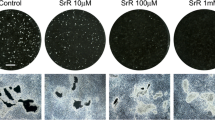Summary
The water-soluble active principle of the plantSolanum malacoxylon (SM) was partially purified by column chromatography, and its bone-resorbing activity was tested by using an organ culture system of 18-day fetal mouse fibulae prelabeled with45Ca. Three series of experiments were performed. In the first series, the aqueous extract of SM was submitted to Sephadex G-25 chromatography to separate the active substances. From six collected fractions only two exhibited reproducible bone-resorbing activity as indicated by an increased release of45Ca from bone rudiments. In the second series, the active fractions were combined and lyophilized to a powder which was dissolved in the culture media to obtain the concentrations of 5, 25, 50, and 100 μg/ml. The addition of this saltfree material resulted in a dose-related accentuation of45Ca release from fetal mouse bones into the medium. Histologically, the treated fibulae showed greater numbers of osteoclasts than the controls and a disappearance of bone trabeculae. In the third series, the active material was further purified on Sephadex LH-20 column. From four collected fractions, only one showed bone-resorbing activity in vitro. It is concluded that the purified active factor of SM exerts a direct effect on bone. It stimulates the mobilization of bone calcium in vitro by increasing the population of osteoclasts. The nature of the active principle remains unknown.
Similar content being viewed by others
References
Wasserman, R.H.: Active vitamin D-like substances inSolanum malacoxylon and other calcinogenic plants. Nutr. Rev.33, 1–5 (1975)
Worker, N.A., Carillo, B.J.: “Enteque seco,” calcification and wasting in grazing animals in the Argentine. Nature215, 72–74 (1967)
Campos, C.M., Ladizesky, M., Mautalen, C.: Effect ofSolanum malacoxylon on the serum levels of calcium and phosphate in thyroparathyroidectomized rats. Calcif. Tissue Res.13, 245–248 (1973)
Djafar, M.I., Davis, G.K.: Some properties of an unknown toxic substance present in the plantSolanum malacoxylon. Mal. Agric. Res.1, 104–108 (1972)
Humphreys, D.J.: Studies on the active principle ofSolanum malacoxylon. Nature [New Biol.]246, 155–157 (1973)
Moorhead, J.F., Humphrey, D.J., Varghese, Z., Basudde, C.D.K., Jenkins, M.V., Wills, M.R.: Studies on “vitamin D like action” ofSolanum malacoxylon, In: Vitamin D and problems related to uremic bone disease (Norman, A.W., Schaefer, K., Grigoleit, H.G., Herrath, D.V., Ritz, E., eds.), pp. 725–730. Berlin: Walter de Gruyter 1975
Basudde, C.D.K., Humphreys, D.J.: The effect of the active principle ofSolanum malacoxylon on rabbits and the inhibition of its action by actinomycin D. Calcif. Tissue Res.18, 133–139 (1975)
Ladizesky, M., Cabrejas, M., Montoreano, R., Mautalen, C.: The effect ofSolanum malacoxylon on the intestinal and renal handling of calcium and phosphate in the rat. In: Vitamin D and problems related to uremic bone diseas (Norman, A.W., Schaeffer, K., Grigoleit, H.G., Herrath, D.V., Ritz, E., eds.), pp. 709–716, Berlin: Walter de Gruyter 1975
Mautalen, C.: Mechanism of action ofSolanum malacoxylon upon calcium metabolism in the rabbit. Endocrinology90, 563–567 (1972)
Narbaitz, R., Carrillo, B.J.: Production of hypercalcemia in chick embryo by an extract ofSolanum malacoxylon. Rev. Can. Biol.35, 181–184 (1976)
Corradino, R.A., Wasserman, R.H.: 1,25-Dihydroxycholecalciferol-like activity ofSolanum malacoxylon extract on calcium transport. Nature256, 716–718 (1974)
Walling, M.W., Kimberg, D.V., Lloyd, W., Wells, H., Procsal, D.A., Norman, A.W.:Solanum glaucophyllum (malacoxylon): An apparent source of a water-soluble, functional and structural analogue of 1-alpha, 25-dihydroxyvitamin D3. In: Vitamin D and problems related to uremic bone disease (Norman, A.W., Schaefer, K. Grigoleit, H.G., Herrath, D.V., Ritz, E., eds.), pp. 717–729. Berlin: Walter de Gruyter 1975
Peterlik, M., Wasserman, R.H.: 1,25-Dihydroxycholecalciferol-like activity insolanum malacoxylon: purification and partial characterization. FEBS Lett.56, 16–19 (1975)
Herrath, D., Schaefer, K., Kraft, D., Offerman, G.: Effect ofSolanum malacoxylon on calcium metabolism in experimental uremia and uremic patients. In: Vitamin D and problems related to uremic bone disease (Norman, A.W., Schaefer, K., Grigoleit, H.G., Herrath, D.V., Ritz, E., eds.), pp. 703–708. Berlin: Walter de Gruyter 1975
Puche, R.C., Locatto, M.E., Ferretti, J.L., Fernandez, M.C., Orsatti, M.B., Valenti, J.L.: The effects of long term feeding ofSolanum glaucophyllum to growing rats on Ca, Mg, P and bone metabolism. Calcif. Tissue Res.20, 105–119 (1976)
Lloyd, W., Wells, H., Walling, M.W., Kimberg, D.V.: Stimulation of bone resorption in organ culture by salt-free extracts ofSolanum glaucophyllum. Endocrine Res. Commun.2, 159–166 (1975)
Uribe, A., Holick, M.F., Jorgensen, N.A., DeLuca, H.F.: Action ofSolanum malacoxylon on calcium metabolism in the rat., Biochem. Biophys. Res. Commun.58, 257–262 (1974)
Skliar, M.I., DeBoland, A.P., Boland, R.L., Carillo, B.J., Ruksan, B.E.: Purificacion del principo activo delSolanum malacoxylon. Medicine (A. Aires)36, 242–246 (1976)
Wasserman, R.H., Henion, J.D., Haussler, M.R., McCain, T.A.: Calcinogenic factor inSolanum malacoxylon: Evidence that it is 1,25-dihydroxyvitamin D3-glucoside. Science194, 853–855 (1976)
Liskova, M.: Influence of estrogens on bone resorption in organ culture. Calcif. Tissue. Res.22, 207–218 (1976)
Kuczerpa, A.V.: A rapid ultramicro-method with an enhanced stability and rang efor the photometric determination of calcium using glyoxal bis (2-hydroxyanil). Anal. Chem.40, 581–585 (1968)
Reynolds, J.J.: Skeletal tissue in culture. In: The biochemistry and physiology of bone (Bourne, G.H., ed.), 2nd ed., Vol. 1, pp. 70–126. New York: Academic Press 1972
Mahgoub, A., Sheppard, H.: Effect of hydroxy-vitamin D3 derivatives on45Ca release from rat fetal bones in vitro. Endocrinology100, 629–634 (1977)
Raisz, L.G., Trummel, C.L., Holick, M.F., DeLuca, H.F.: 1,25-Dihydroxycholecalciferol: a potent stimulator of bone resorption in tissue culture. Science175, 768–769 (1972)
Reynolds, J.J., Holick, M.F., DeLuca, H.F.: The role of vitamin D metabolites in bone resorption. Calcif. Tissue Res.12, 295–301 (1973)
Stern, P.H., Trummel, C.L., Schnoes, H.K., DeLuca, H.F.: Bone resorbing activity of vitamin D metabolites and congeners in vitro: Influence of hydroxyl substitutes in the A ring. Endocrinology97, 1552–1558 (1975)
Author information
Authors and Affiliations
Rights and permissions
About this article
Cite this article
Liskova-Kiar, M., Proschek, L. Influence of partially purified extracts ofSolanum malacoxylon on bone resorption in organ culture. Calc. Tis Res. 26, 39–45 (1978). https://doi.org/10.1007/BF02013232
Received:
Revised:
Accepted:
Issue Date:
DOI: https://doi.org/10.1007/BF02013232



